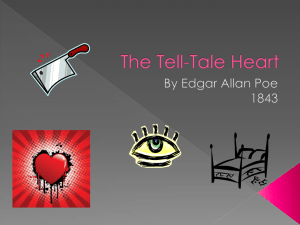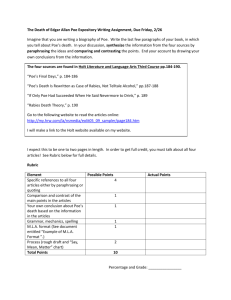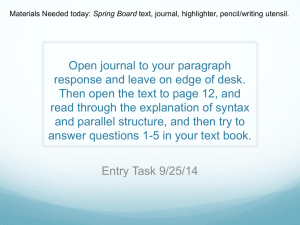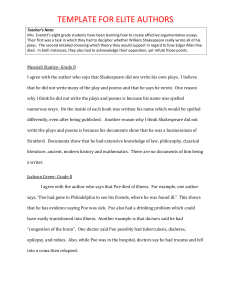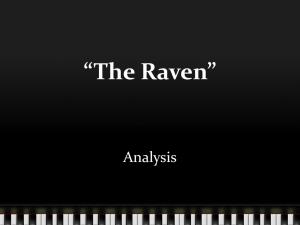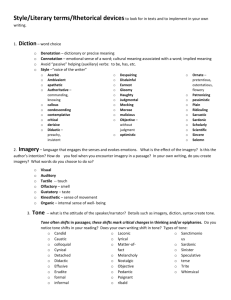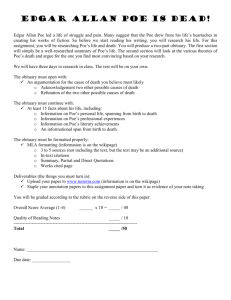Timed-Writing Frequent
advertisement
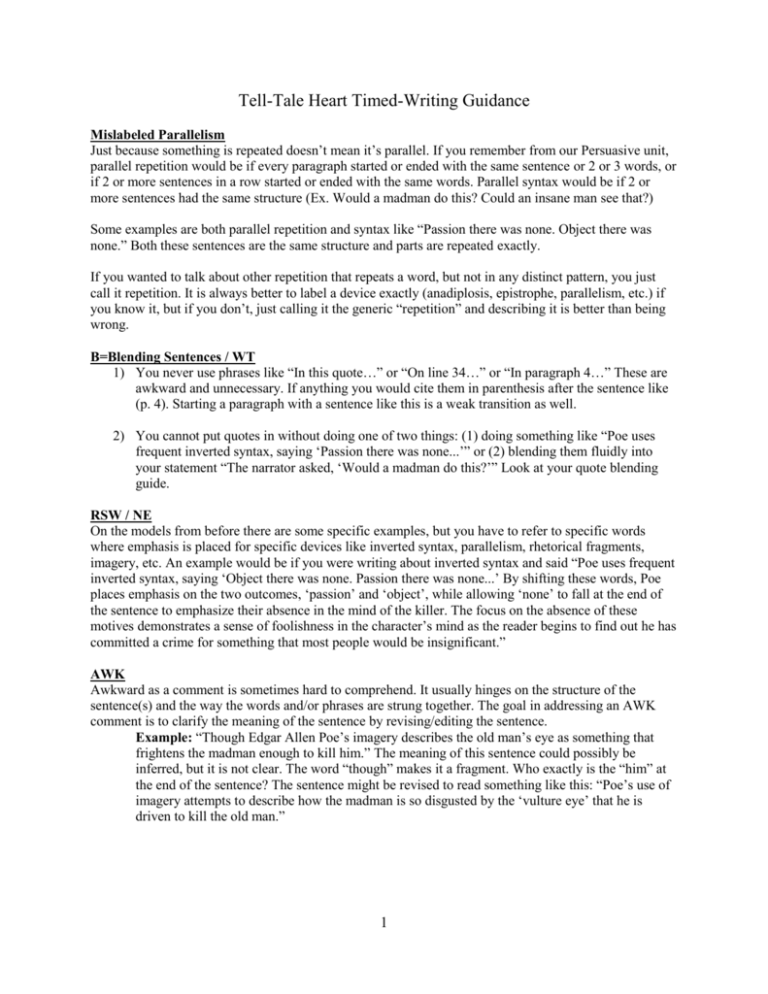
Tell-Tale Heart Timed-Writing Guidance Mislabeled Parallelism Just because something is repeated doesn’t mean it’s parallel. If you remember from our Persuasive unit, parallel repetition would be if every paragraph started or ended with the same sentence or 2 or 3 words, or if 2 or more sentences in a row started or ended with the same words. Parallel syntax would be if 2 or more sentences had the same structure (Ex. Would a madman do this? Could an insane man see that?) Some examples are both parallel repetition and syntax like “Passion there was none. Object there was none.” Both these sentences are the same structure and parts are repeated exactly. If you wanted to talk about other repetition that repeats a word, but not in any distinct pattern, you just call it repetition. It is always better to label a device exactly (anadiplosis, epistrophe, parallelism, etc.) if you know it, but if you don’t, just calling it the generic “repetition” and describing it is better than being wrong. B=Blending Sentences / WT 1) You never use phrases like “In this quote…” or “On line 34…” or “In paragraph 4…” These are awkward and unnecessary. If anything you would cite them in parenthesis after the sentence like (p. 4). Starting a paragraph with a sentence like this is a weak transition as well. 2) You cannot put quotes in without doing one of two things: (1) doing something like “Poe uses frequent inverted syntax, saying ‘Passion there was none...’” or (2) blending them fluidly into your statement “The narrator asked, ‘Would a madman do this?’” Look at your quote blending guide. RSW / NE On the models from before there are some specific examples, but you have to refer to specific words where emphasis is placed for specific devices like inverted syntax, parallelism, rhetorical fragments, imagery, etc. An example would be if you were writing about inverted syntax and said “Poe uses frequent inverted syntax, saying ‘Object there was none. Passion there was none...’ By shifting these words, Poe places emphasis on the two outcomes, ‘passion’ and ‘object’, while allowing ‘none’ to fall at the end of the sentence to emphasize their absence in the mind of the killer. The focus on the absence of these motives demonstrates a sense of foolishness in the character’s mind as the reader begins to find out he has committed a crime for something that most people would be insignificant.” AWK Awkward as a comment is sometimes hard to comprehend. It usually hinges on the structure of the sentence(s) and the way the words and/or phrases are strung together. The goal in addressing an AWK comment is to clarify the meaning of the sentence by revising/editing the sentence. Example: “Though Edgar Allen Poe’s imagery describes the old man’s eye as something that frightens the madman enough to kill him.” The meaning of this sentence could possibly be inferred, but it is not clear. The word “though” makes it a fragment. Who exactly is the “him” at the end of the sentence? The sentence might be revised to read something like this: “Poe’s use of imagery attempts to describe how the madman is so disgusted by the ‘vulture eye’ that he is driven to kill the old man.” 1 M=Misinterpretation Time is needed when initially reading to correctly identify the purposeful use of rhetorical devices and to accurately make sense of the text. “M” means you misidentified a rhetorical device, its use, or the most reasonable interpretation of its use. Sometimes simple wording may create a misguided or inaccurate interpretation. Real thought and reflection are needed to interpret an “M” comment and then correct it. Example: “Unique narrative perspective and inverted syntax are used to re-tell a killer’s introduction to his glorious kill, in fascinating ways in the murderer’s defense.” Problem: It cannot be strongly argued that Poe is trying to “defend” the murder. Rather, the narrator’s attempt at defending his sanity is a clear sign that he is insane (trying to rationalize a violent asocial crime). The fact that he is insane is the most logical and reasonable point being made through Poe’s use of the named rhetorical devices. Perhaps the writer meant to make this very point, but, as written, it seems to be a misinterpretation. General Thesis / NSOM/OT You needed to identify the specific literary/rhetorical devices in the thesis and specific mental traits they bring out, not just saying they demonstrate the character’s “complex state-of-mind.” DI / DC The introduction should be more than just a thesis. It should be 3-4 sentences that interestingly make a point related to the prompt as well as include the thesis. Likewise the conclusion, although summative, should not be just a summary. It should also make a closing point AND it should reconnect the ideas of the essay to the prompt as well. See the models for examples of how past students have successfully created strong introductions and conclusions. G This is when you have said things like “to develop the character’s complex mind” or continually repeated the character is “insane” without actually saying the real issues that show this insanity (a.k.a. illogical thinking, sharply contrasting thoughts, arrogance, etc.) or stated that the character’s “feelings” are shown without saying what they are. RDW All your quotes need to show the devices you claim. You don’t quote ANYTHING that doesn’t show the device because that is the basis for your thesis. If you say Poe uses repetition, then every quote you use needs to show repetition or you say he REPEATS the word “___________” to emphasize something. If you say Poe uses parallelism, then EVERY quote you use has to show parallelism in it. If you say Poe uses imagery, then EVERY quote you use has to have imagery in it. ETC. EUP/UNP/NED/AED You need to describe how the device you claim was used actually affected the meaning. You can’t just explain the words for many devices, but need to explain the device itself. For example, if you say 1st person POV, you need to explain what was unique about using that POV for this story. It is used all the time. If you are going to talk about it, there has to be something different about it in this circumstance. You should also have realized he uses 2nd person as well to talk directly to the reader, but just identifying that isn’t enough. You have to discuss how that helps developing the characteristics of the narrator. Another example would be Inverted Syntax. If you claim inverted syntax helps develop the character, you have to explain how the shifting of the word order helped emphasize different ideas because that is what inverted syntax does is shift word order to put more emphasis on certain words at the beginning and end of phrases. 2
